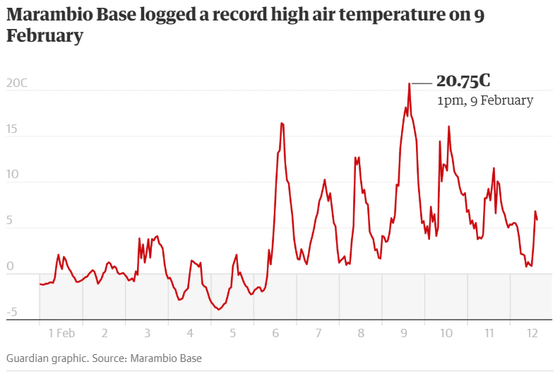Maximum temperature exceeds 20 ° C for the first time in Antarctic observation history

'Temperatures in excess of 20 degrees Celsius have been observed in Antarctica,' and remote monitoring scientists describe the new record as 'incredibly abnormal.'
Antarctic temperature rises above 20C for first time on record | World news | The Guardian
The highest temperature exceeded 20 degrees Celsius on Seymour Island, which is closest to the South American continent on the Antarctic Peninsula . The maximum temperature of 20.75 degrees Celsius recorded at 13:00 on February 9 exceeded the record of 19.8 degrees Celsius observed on Signy Island in January 1982.

In Antarctica, the Antarctic Research Station in Argentina just observed a maximum temperature of 18.3 degrees Celsius on February 6, 2020.
A temperature of `` 18.3 ℃ '' is recorded in Antarctica, possibility of updating the highest temperature in the past-gigazine

Although it needs to be confirmed by the World Meteorological Organization (WMO) in order to be recognized as a formal record, the observation record of 20.75 degrees is consistent with the warming trend confirmed throughout Antarctica. `` There are warming trends in many places that monitor temperature, but never more than 20 degrees, '' said Carlos Shafer, who works for a meteorological observation facility as part of a project of the Brazilian government. It was. '
According to Shafer, temperatures around Seymour Island, the South Shetland Islands , and James Ross Island have been unstable over the past two decades, and have been cooling for 10 years since 2001, followed by rapid warming. That's right. Shaffer claims that 'we are affected by changes in currents and the El Nino phenomenon .'
In addition, Antarctica has a huge amount of ice, and the Antarctic ice sheet is said to store about 70% of the earth's freshwater . Melting this ice sheet has led to sea-level rise, suggesting that some coastal cities may be submerged. In addition, sea ice and are seen as a greater impact on wildlife to an important habitat, the actual distribution from South America southern tip to around Antarctica chinstrap penguins inhabit the number of is reduced more than 50%, the It has been reported .

'It's important to have monitoring areas like the South Shetland Islands and the Antarctic Peninsula, because monitoring can anticipate developments that will occur in the near future,' she said.
Related Posts:






